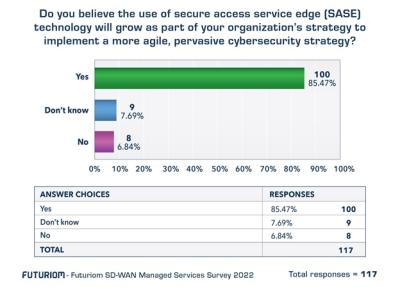
Enterprise end users have embraced the Secure Access Service Edge (SASE) ecosystem and are hungry for a wide range of SASE managed services offered by service providers, primary research and survey data from Futuriom shows.
The strong end-user desire to integrate networking with security functions executed either on premises or from the cloud will underpin continued growth in SASE managed services. That is driving SASE technology platform vendors as they continue to jostle for position, as service providers pick partners and increase their SASE managed services offerings.
Networking and security convergence
SASE and SASE managed services really represent a convergence of networking and security technologies in the virtualized worlds. End users would like to buy the two together.
In the current world, cybersecurity threats are a daily headache in both IT and networking circles. In our conversations and survey work with end users, they are overwhelmed with the proliferation of security tools and integrations. SASE has emerged as a way to kill two birds with one stone: As new network services are deployed using software-defined wide-area networking (SD-WAN) tools, it makes sense to use the convenience of Application Programming Interfaces (APIs) to connect to a wide variety of cloud-based security, whether that be Secure Web Gateways (SWG), Zero Trust Network Access (ZTNA), Firewall-as-a-Service (FWaaS) or other security applications.

This was confirmed in the Futuriom 2022 survey of 118 enterprise networking and security professionals in North America, all of whom held job roles at director-level and above. When asked if SASE was seen as a way to implement a more agile, pervasive cybersecurity strategy, 86% of respondents said yes.
There are additional benefits of SASE, as well. End users surveyed see SASE not just as a way to integrate network connectivity and security services at the enterprise edge, but also as a platform for connecting to cloud. When asked about a hybrid solution that could manage security in both on-premises locations as well as cloud points of presence (PoPs), end users also embraced the technology, with 84% responding yes to this question.
Additional trends: Hybrid work and internet growth
There’s another monster driver of the SASE movement: Hybrid work environments and the expanded use of the internet for business applications.
Broadband connectivity has made the Internet a more viable option for business applications – and this will only increase with more investment in fiber and 5G. The internet broadband trend was first instrumental in boosting SD-WAN, which used internet connections to supplement or replace traditional private connections such as multiprotocol label switching (MPLS), which are generally more expensive services.
The internet is especially adaptable for remote work because of its ubiquity. But securing the internet is another question. Because most SASE architectures can also be used to further secure the internet for remote work as well as segment business applications with policy, it’s a natural complement to efforts to transition networks to the remote work force.
For example, when 118 enterprise networking end users were asked if digitization and hybrid work environment has increased the need for SASE managed services, 86% replied “yes.”
Major global service providers have of course recognized this fact and have scrambled to set up a wide array of SASE managed services based on the major vendor SASE and SD-WAN platforms.
In just a few examples, AT&T has adopted SASE platforms from Cisco, Fortinet, Aruba Networks and Palo Alto Networks. Comcast uses Cisco, Fortinet, Palo Alto and Versa Networks. Deutsche Telekom is using Aryaka Networks, Juniper Networks, Aruba and Versa as part of its SASE managed services.
Aryaka and Cato Networks have emerged as the leaders with standalone networks with managed SASE services. Aryaka recently beefed up its security offerings in 2021 by purchasing German ZTNA technology specialist Secucloud as well as adding layer 3 routing underlay to its own network.
New SASE managed services continue to roll out every month. Most recently, MetTel and VMware launched a new managed SASE service. Tata Communications has expanded its IZO SD-WAN and Managed SASE service with Cisco, Fortinent, Palo Alto and Zscaler. It also offers thin-branch ZTNA solution with NetFoundry. Telefónica has expanded SASE offerings with vendors such as Fortinet and Zscaler.
With compelling trends such as security and networking integration as well as hybrid work driving the security needs of enterprises, SASE managed services are likely to be a fertile area of growth for service providers and vendors alike. It could also be a boon to enterprise networking end users, who would like to purchase and consume network-based security services as software on demand – which is exactly the direction that the SASE managed services market is heading.
R. Scott Raynovich is the founder and chief analyst of Futuriom. For two decades, he has been covering a wide range of technology as an editor, analyst, and publisher. He has won several industry awards, including an Editor & Publisher award for Best Business Blog, and his analysis has been featured by prominent media outlets including NPR, CNBC, The Wall Street Journal, and the San Jose Mercury News. He can be reached at [email protected]; follow him @rayno.
Industry Voices are opinion columns written by outside contributors—often industry experts or analysts—who are invited to the conversation by FierceTelecom staff. They do not represent the opinions of FierceTelecom.
